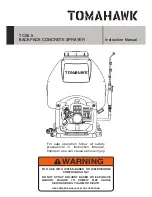
FOR OPTIMUM PERFORMANCE IT IS VERY IMPORTANT TO ENSURE THE GUN IS CORRECTLY CLEANED AFTER EACH USE.
Disconnect from the air supply before attempting any cleaning or maintenance.
5.1. Cleaning the gun
5.1.1. Immerse the front end of the gun only in solvent. The solvent should just cover the fluid connection.
5.1.2. Use a bristle brush and solvent to wash off accumulated paint.
5.1.3. Do not immerse the entire gun in solvent as this will cause lubricants on the rubber seals to dissolve. Dirty solvent may also clog
narrow passages in the gun.
5.1.4. Flush the gun through with clean thinners.
5.1.5. Wipe the outside of the gun with a dampened solvent rag.
5.2.
Air nozzle, fluid nozzle and needle assembly
5.2.1. To clean the nozzles, soak them in solvent to dissolve any dried material then blow them clean with air. Handle all nozzles carefully
and do not make any alterations in the gun.
5.2.2. If you need to probe the holes in the nozzles, be sure to use a tool that is softer than brass; do not use metal instruments.
5.2.3. Adjust the fluid needle valve so that when the gun is triggered, air flow occurs before fluid flow.
5.3. Maintenance
Take care when re-assembling. Screw parts hand tight to avoid cross-threading. If a part cannot easily be turned by hand, check that
you have the correct part, or unscrew, realign and try again.
DO NOT
use excessive force when re-assembling.
5.3.1. Lubricate the gun daily with a light machine oil.
5.3.2. If you change the nozzle size, ensure the complete nozzle set is exchanged. Insert paint nozzle before putting the paint needle in.
5.3.3. To change the needle packing use the socket spanner provided. Note: Handle the teflon seal and self tensioning spring with care.
5. CLEANING & MAINTENANCE
4. OPERATING INSTRUCTIONS
4.1.
For best results, make sure to handle the gun correctly. It should be held perpendicular to the surface being sprayed and moved
parallel to it. Start the stroke before squeezing the trigger and release the trigger before finishing the stroke. This will enable you to
accurately control the gun and material (fig.3).
4.2.
Spray from a distance of about 150mm (6") to 250mm (10") depending on the material and the atomizing pressure. The material
deposited should always be even and wet. Each stroke must overlap the preceding stroke to obtain a uniform finish. To reduce over
spray and obtain maximum efficiency, spray with the lowest possible atomizing air pressure.
4.3.
Controlling the fan spray and the fluid.
a) The atomizing air flow is controlled by using the regulator attached to the incoming air supply which should be capable of
supplying between 5 and 11cfm.
b) Use the adjustment knob (fig.4.4) to increase or decrease the amount of paint flowing in from the gravity feed pot.
c) The width of the spray can be adjusted using knob (fig.4.5).
d) As width of spray is increased more material must pass through the gun to obtain the same coverage on the increased area.
e) Turn the air nozzle (fig.4.1) to achieve a horizontal or vertical fan spray. Lock the nozzle with retaining ring (fig.4.2).
The spray pattern of the gun is variable from round to flat with all patterns in between. In normal operation, the wings on the
nozzle are horizontal as fig.4, this provides a vertical fan-shaped pattern which gives maximum uniform and even coverage when
moving the gun back and forth, parallel to the work surface (fig.5).
fig.3
fig.4
fig.5
Original Language Version
© Jack Sealey Limited
SSG502 Issue: 1 - 05/04/13





















